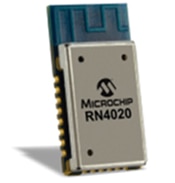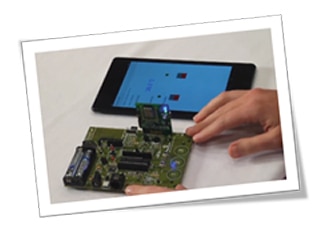Low-Power Consumption, Communication, and Security in Industrial IoT Designs
2016-04-21
Power consumption and security are two of the foremost concerns for embedded system designers, especially in IoT sensor command and control applications.
It is important for industrial IoT designs that a microcontroller not only consumes as little average power as possible, but also provides features that allow for minimal power consumption in the rest of the design as well.
For low- or battery-power-only applications, Microchip’s eXtreme Low-Power (XLP) Technology found on the PIC24F microcontroller family enables very-low-energy basic command and control communication for IoT sensors via a Bluetooth® LE (BLE) connection and added security with an integrated hardware encryption engine.
Extreme Low-Power
As more electronic applications require low or battery power, energy conservation becomes paramount. Today’s applications must consume little power and, in some extreme cases, last up to 20+ years while running from a single battery. To enable applications like these, products with Microchip’s eXtreme Low-Power (XLP) Technology offer very-low sleep currents, where extreme-low-power applications spend 90-99% of their time. As seen in Figure 1, 16-bit XLP technology enables sleep currents down to 40 nA and run currents down to 180 μA/MHz.
| Flash Memory and Pins | Lowest Sleep Current | Lowest Sleep with WDT | Lowest Sleep with RTCC |
|---|---|---|---|
| 64-128 KB 28-44 pins |
40 nA, 3.3 V typical | 270 nA at 3.3 V typical | 400 nA at 32 kHz, 3.3 V typical |
Figure 1: PIC24FJ128GB204 Current Consumption for Different Sleep Modes
A great example of this type of extreme-low-power device is the Microchip PIC24FJ128GB204 microcontroller. It has multiple power management options for extreme power reduction and flexible wake-up resources such as deep sleep, allowing near total power-down with the ability to wake-up on internal or external triggers, such as when an environmental sensor needs to take asynchronous/periodic readings. Sleep and Idle modes selectively shut down peripherals and/or the core for substantial power reduction and fast wake-up for those more critical application interrupts, such as in a security camera motion detector. Doze mode allows the CPU to run at a lower clock speed than peripherals and an alternate clock mode enables on-the-fly switching to a lower clock speed for selective power reduction. Another new sleep mode is low-voltage retention sleep which has essential circuits being powered from a separate low-voltage regulator. It also has a Vbat pin which allows the device to transition to a back-up battery for the lowest power consumption for the real-time clock/calendar.
Having a microcontroller that enables extreme low-power with many flexible sleep and wake modes is critical in a power-constrained application. Low-power is also critical in all system functions such as communications.
Low-Energy Communication
When sensing data and executing code, applications need to process and transmit information as fast and efficiently as possible, and then go back to sleep in order to optimize battery life. Many applications only need simple command and control, or a quick status update from a sensor. By catering to these needs, Bluetooth Low-Energy (LE) has evolved to support these low-duty cycle applications. According to the Bluetooth SIG specification page, "Bluetooth LE—allows for short bursts of long-range radio connection, making it ideal for Internet of Things (IoT) applications that don’t require continuous connection but depend on long battery life." BLE operates in the same spectrum band (2.400 GHz to 2.4835 GHz ISM band) as Classic Bluetooth technology, but uses a different set of channels and different modulation techniques. You can read more on the BLE 4.x specification on the Bluetooth SIG website under specifications.
Microchip supports BLE with the RN4020, a fully-certified, Bluetooth Version 4.1 low-energy module for designers who want to easily add low-power wireless capability to their products. The small form factor, surface-mount module has the complete Bluetooth stack on-board and is controlled via simple ASCII commands over the UART interface. The RN4020 (Figure 2) includes all Bluetooth SIG profiles, as well as MLDP (Microchip Low-energy Data Profile) for custom data. Microchip also has other products supporting later versions of the BLE spec, such as the BM71 Bluetooth (4.2) Low-Energy module which is designed for easy implementation into a broad range of applications. Supporting the latest Bluetooth standard, it delivers up to 2.5x throughput improvement and more secure connections vs. Bluetooth 4.1-based products.

Figure 2: Microchip's RN4020 Bluetooth Low-Energy Module
For low-power Wide Area Networks (WANs), the LoRaWAN™ protocol stack is available onboard Microchip's LoRa® module. The LoRaWAN protocol easily connects to LoRa gateways and network servers, providing seamless interoperability among Smart devices.
In addition to the low-energy connection to the Internet, many applications also have data security transfer and storage requirements.
Integrated Hardware Encryption for Data Protection
Secure data storage is important for many applications, including applications that focus on data logging, applications that are saving data to a thumb drive, or applications that need to load from multiple configuration files. Whether that data is stored near the MCU on a board with some type of external memory (such as EEPROM) or sent via USB or wirelessly to another device, having encryption is key to protecting the data integrity and securing communication.
The Microchip PIC24FJ128GB204-i microcontroller family includes a fully featured and integrated hardware encryption engine including support for AES, DES, and Triple DES. A random number generator is included and is used to create keys for data encryption/decryption and authentication and provides a higher level of security by making the keys difficult to reproduce. A One-Time-Programmable (OTP) Key storage protects the encryption key from being read or overwritten by software.
By implementing these features in hardware (instead of software), this reduces software overhead, and processing bandwidth. Integrated hardware AES is ~10 times faster compared to software AES. This speed advantage allows you to operate the MCU at a lower frequency, which saves power consumption. Hardware-enabled protection is ideally suited for low-duty-cycle applications or low-power embedded security applications such as security cameras, door locks and panels, Smartcard readers, POS terminals, and voting machines.
The integrated hardware encryption engine, found on the PIC24FJ128GB204 family of products, is considered a Core Independent Peripheral (CIP). Once initialized in a system, CIPs can provide steady-state closed-loop embedded control with zero intervention from the MCU’s core. As a result, they simplify the implementation of complex control systems and give designers the flexibility to innovate.
One example of how this embedded security has been implemented can be found on the PIC24 XLP device with secure sensor data.
Sensors in IoT
There are many different types of sensors that could be used in an IoT application, depending on the nature of the event that needs to be detected. Sensor categories include environmental, motion, light, physical, chemical, and electrical, but could extend far beyond this to include many other domains such as navigation, optical, pressure, force, and proximity just to name a few. The end goal is to create an interaction between an end user or a machine and the embedded system capturing data or controlling actuators. The obvious choice for user interface with Bluetooth applications is mobile technology.
Microchip has developed a PIC24 XLP Bluetooth LE IoT Demo (Figure 3) that shows off this basic sensor capability. The demo is built using standard development tools from Microchip including the Explorer 16 Board, PIC24FJ128GB204 Processor Plug-In Module (PIM), and Bluetooth LE PICtail Plus Daughter Card. These readily available tools can be used to easily replicate this demo on your own. The demo is supported by MCU firmware and an app that will run on an Android phone or tablet. The first application is turning the LEDs on and off using the touch buttons on the tablet, demonstrating basic bi-directional command and control. The app can also show the state of the switches on the board, toggling on and off. The demo also includes data security using the crypto engine integrated on the PIC24FJ128GB204 MCU, with up to 128-bit AES and a Microchip TC1074A analog output thermal sensor connected to one of the microcontroller’s A/D channels.

Figure 3: Microchip PIC24F XLP Bluetooth LE IoT Demo
Getting the secure IoT sensor data to the cloud has many benefits, read on to learn more.
Connecting to the Cloud
For an IoT device, there are many benefits of connecting to the cloud. Examples include remote command and control, remote diagnostics and field reprogrammability, profile and status, and push notifications, just to name a few. There are also many potential paths from your IoT product to the cloud. A few common configurations include 1) Wi-Fi® through a router, 2) Bluetooth via a cell connection, 3) Ethernet through a router, 4) LoRa through a gateway, and 5) MiWi through a gateway and router. With a variety of wireless solutions, sensors and eXtreme Low-Power microcontrollers, Microchip products enable end-to-end IoT solutions, including the final product and the required connectivity to help you successfully connect your embedded system to the cloud.
Conclusion
Power consumption and security are two of the foremost concerns for embedded system designers, not only for the microcontroller but in the rest of the IoT design as well. For low- or battery-power-only applications, Microchip has a suite of products ideal for these applications that include eXtreme Low-Power (XLP) Technology microcontrollers offering very low currents, address security with an integrated hardware encryption engine, and multiple communication paths to connect to the cloud.
Disclaimer: The opinions, beliefs, and viewpoints expressed by the various authors and/or forum participants on this website do not necessarily reflect the opinions, beliefs, and viewpoints of DigiKey or official policies of DigiKey.









